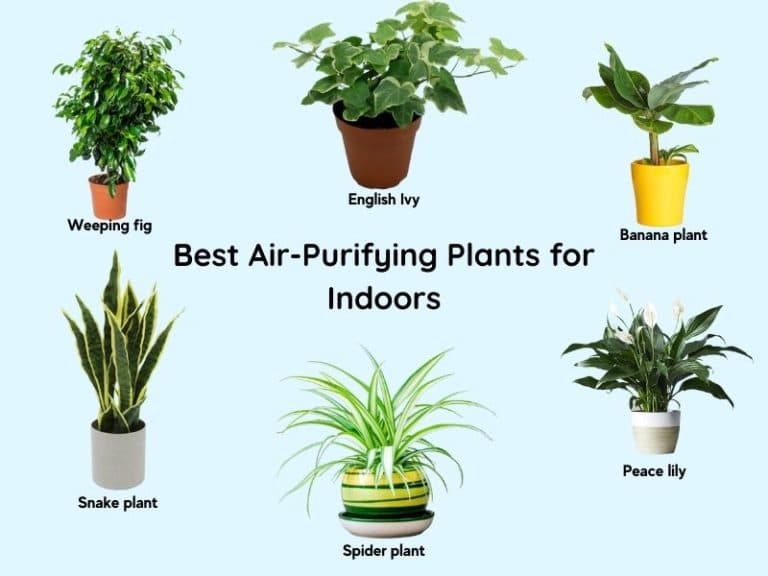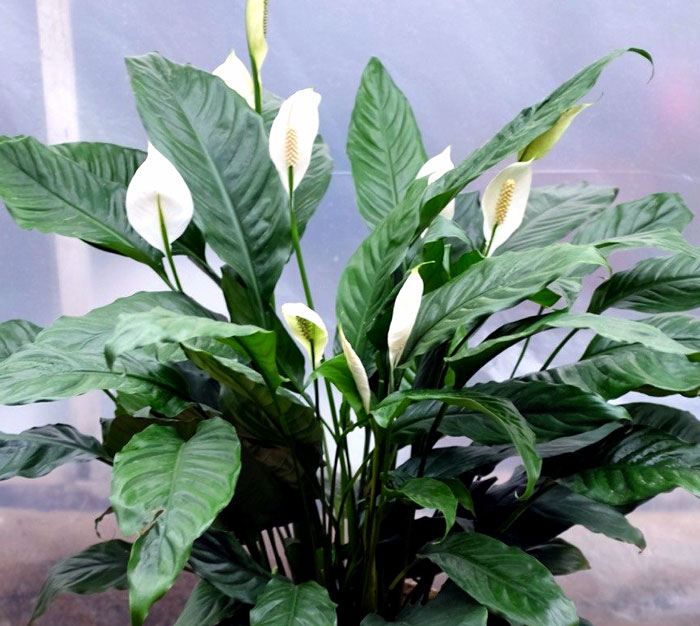Top Indoor Plants for Air Purification: Best Indoor Plants For Air Purification
 Best indoor plants for air purification - Bringing nature indoors isn't just about aesthetics; it can also significantly improve your indoor air quality. Many plants are natural air purifiers, absorbing harmful toxins and releasing oxygen, creating a healthier environment for you and your family. Let's explore some of the top contenders for your home.
Best indoor plants for air purification - Bringing nature indoors isn't just about aesthetics; it can also significantly improve your indoor air quality. Many plants are natural air purifiers, absorbing harmful toxins and releasing oxygen, creating a healthier environment for you and your family. Let's explore some of the top contenders for your home.
Top 10 Indoor Plants for Air Purification
The NASA Clean Air Study identified several plants that effectively remove volatile organic compounds (VOCs) from the air. These compounds are emitted from common household products like paints, cleaners, and furniture, and can contribute to indoor air pollution. Here are 10 of the most effective:
| Plant Name | Common Name | Air Purifying Properties | Care Requirements |
|---|---|---|---|
| Chlorophytum comosum | Spider Plant | Removes formaldehyde, xylene, and toluene. | Easy to care for, tolerates low light, and can be propagated easily. |
| Dracaena marginata | Dragon Tree | Removes formaldehyde, xylene, and trichloroethylene. | Prefers bright, indirect light and well-draining soil. |
| Sansevieria trifasciata | Snake Plant | Removes formaldehyde, benzene, and trichloroethylene. | Very low maintenance, tolerates low light and infrequent watering. |
| Ficus benjamina | Weeping Fig | Removes formaldehyde, toluene, and xylene. | Requires bright, indirect light and consistent humidity. |
| Epipremnum aureum | Pothos | Removes formaldehyde, benzene, and carbon monoxide. | Extremely adaptable, tolerates low light and infrequent watering. |
| Peace Lily | Spathiphyllum wallisii | Removes formaldehyde, ammonia, and trichloroethylene. | Prefers bright, indirect light and consistently moist soil. |
| Aloe vera | Aloe Vera | Removes formaldehyde and benzene. | Requires bright, direct light and well-draining soil. |
| ZZ Plant | Zamioculcas zamiifolia | Removes xylene and toluene. | Very low maintenance, tolerates low light and infrequent watering. |
| English Ivy | Hedera helix | Removes formaldehyde, benzene, and toluene. | Prefers bright, indirect light and consistently moist soil. |
| Gerbera Daisy | Gerbera jamesonii | Removes benzene and trichloroethylene. | Requires bright, indirect light and well-draining soil. |
Selecting the Right Plants for Your Home
Choosing the right plants for your home involves considering several factors:
- Lighting Conditions: Some plants thrive in bright, direct light, while others prefer shade. Determine the amount of light your space receives and select plants that will flourish in those conditions.
- Humidity Levels: Certain plants require higher humidity levels than others. If your home is dry, consider plants like the weeping fig or peace lily that enjoy a more humid environment.
- Personal Preferences: Ultimately, choose plants that you find visually appealing and enjoyable to care for. The beauty of indoor plants lies in their ability to enhance both your air quality and your living space.
Plant Care and Maintenance
Bringing greenery into your home not only enhances its aesthetics but also provides a myriad of benefits, including improved air quality. However, maintaining the health and vitality of these indoor plants requires a certain level of dedication and understanding of their specific needs.
Watering
The frequency and amount of water required for each plant vary greatly based on factors such as species, pot size, and environmental conditions.
- Overwatering: A common mistake is overwatering, which can lead to root rot and ultimately, plant death. Always allow the top inch of soil to dry out before watering again.
- Underwatering: On the other hand, underwatering can cause wilting and leaf drop. Regularly check the soil moisture and water when it feels dry to the touch.
- Watering Technique: When watering, thoroughly soak the soil until water drains from the drainage holes. Avoid letting water sit in the saucer for prolonged periods, as this can lead to root problems.
Light
Sunlight is essential for photosynthesis, the process by which plants convert light energy into food.
- Direct Sunlight: Some plants, like succulents, thrive in direct sunlight, while others, like ferns, prefer indirect light.
- Indirect Sunlight: Most indoor plants benefit from bright, indirect light, which is light that has been filtered through a window or shade.
- Artificial Light: If natural light is limited, consider using grow lights to supplement the plant's light requirements.
Fertilization, Best indoor plants for air purification
Indoor plants require regular fertilization to provide them with the necessary nutrients for growth.
- Fertilizer Type: Use a balanced liquid fertilizer specifically formulated for indoor plants.
- Frequency: Fertilize every 2-4 weeks during the growing season (spring and summer).
- Overfertilization: Avoid overfertilizing, as this can burn the roots and damage the plant.
Signs of a Healthy Plant
- Vibrant Green Leaves: Healthy plants have vibrant green leaves that are free from pests, diseases, and discoloration.
- Strong Growth: A healthy plant will exhibit strong, upright growth and new leaf development.
- Healthy Roots: When repotting, healthy roots will be white and firm.
Addressing Common Issues
- Pests: Common indoor plant pests include spider mites, aphids, and mealybugs.
- Diseases: Fungal diseases, such as root rot, are often caused by overwatering.
Repotting Indoor Plants
Repotting is necessary when the plant's root system becomes too large for its current pot.
- Choose a Pot: Select a pot that is one size larger than the current pot.
- Prepare the Pot: Fill the new pot with fresh potting mix.
- Remove the Plant: Gently remove the plant from its current pot.
- Inspect the Roots: Inspect the roots for signs of damage or root rot.
- Repot the Plant: Place the plant in the new pot and fill in the remaining space with potting mix.
- Water Thoroughly: Water the plant thoroughly after repotting.
Benefits Beyond Air Purification
:max_bytes(150000):strip_icc()/feng-shui-air-purifying-plants-4158078-01-0b71cb652c8347f6a7c0424abf316309.jpg)
While the air-purifying properties of indoor plants are undeniable, their advantages extend far beyond cleaner air. They bring a unique blend of psychological and aesthetic benefits that can significantly enhance our well-being and living spaces.
Psychological Benefits
Indoor plants have a profound impact on our mental well-being. Their presence can create a calming and soothing atmosphere, reducing stress and anxiety. Studies have shown that simply being around plants can lower blood pressure, heart rate, and cortisol levels, all of which are associated with stress.
"Exposure to nature, even in the form of indoor plants, can have a significant impact on our psychological well-being." - Dr. Howard Frumkin, Director of the National Center for Environmental Health
Enhancing Focus and Productivity
The presence of plants can enhance our cognitive abilities, promoting focus and productivity. Studies have shown that incorporating plants into workspaces can lead to improved concentration, memory, and overall performance.
"Plants in the workplace can create a more stimulating and positive environment, leading to increased productivity and reduced stress." - Dr. James Hamblin, author of "If Our Bodies Could Talk"
Boosting Mood and Well-being
Plants can have a positive impact on our mood, bringing feelings of joy, contentment, and a sense of connection to nature. Their vibrant colors and textures can stimulate our senses and create a more uplifting atmosphere.
"The presence of plants can trigger the release of endorphins, which are natural mood boosters." - Dr. Susan Cohen, author of "The Power of Plants"
Aesthetic Enhancements
Beyond their psychological benefits, indoor plants can dramatically enhance the aesthetic appeal of a space. They add a touch of life and vibrancy, transforming a sterile environment into a more inviting and welcoming one.
- Adding Texture and Depth: Plants with varied foliage shapes and textures, such as ferns, succulents, and philodendrons, can create visual interest and depth within a room.
- Introducing Color: Plants with vibrant flowers, such as orchids, African violets, and bromeliads, can inject a splash of color into a space, creating a cheerful and uplifting ambiance.
- Creating Focal Points: Large plants, such as palms, monsteras, and ficus trees, can serve as eye-catching focal points, drawing attention and adding a sense of grandeur to a room.
- Enhancing Natural Light: Plants can help to diffuse and soften natural light, creating a more inviting and comfortable atmosphere, especially in spaces with large windows.
Resources and Further Information

This section provides valuable resources for expanding your knowledge about indoor plants and their benefits, along with practical tips for cultivating a thriving collection.
The world of indoor plants is vast and exciting, offering numerous opportunities to enhance your home's aesthetics and well-being. Whether you're a seasoned plant enthusiast or a curious beginner, there's always more to discover. The resources below will guide you on your journey to becoming a successful plant parent.
Reputable Websites and Organizations
These websites and organizations provide comprehensive information on indoor plants, air purification, and plant care.
- NASA Clean Air Study: This groundbreaking study by NASA identified the top air-purifying plants, providing valuable insights into their effectiveness in removing pollutants.
- Royal Horticultural Society (RHS): The RHS is a renowned gardening organization offering extensive information on plant care, identification, and growing techniques.
- American Horticultural Society (AHS): The AHS provides resources on various aspects of horticulture, including indoor plant care and selection.
- The Spruce: This website offers practical advice on indoor plant care, including plant selection, watering techniques, and troubleshooting common problems.
- Indoor Plants: This website provides a wealth of information on indoor plant care, including plant identification, propagation, and pest control.
Creating a Thriving Indoor Plant Collection
Developing a successful indoor plant collection requires careful planning and attention to detail. Here are some key tips to guide you.
- Start Small: Begin with a few easy-to-care-for plants and gradually expand your collection as you gain experience.
- Choose the Right Plants: Consider your home's lighting conditions, humidity levels, and your personal preferences when selecting plants.
- Provide Proper Care: Research the specific needs of each plant, including watering frequency, light requirements, and fertilization.
- Monitor for Problems: Regularly inspect your plants for signs of pests, diseases, or nutrient deficiencies, and address them promptly.
- Experiment and Learn: Don't be afraid to try new plants and techniques. Gardening is an ongoing learning process.
Identifying and Addressing Common Plant Problems
Even with the best care, indoor plants can sometimes experience problems. Recognizing these issues early can help prevent further damage and ensure your plants thrive.
- Yellowing Leaves: This can indicate overwatering, underwatering, nutrient deficiencies, or pests.
- Brown Spots: These can be caused by fungal diseases, sun scorch, or overwatering.
- Wilting: This usually indicates underwatering, but it can also be a sign of root rot or pests.
- Pests: Common indoor plant pests include aphids, mealybugs, and spider mites.
- Diseases: Fungal diseases, such as powdery mildew and root rot, can affect indoor plants.
For more detailed information on specific plant problems, consult reputable websites and gardening resources.
FAQ Corner
What are the most common indoor air pollutants?
Common indoor air pollutants include volatile organic compounds (VOCs) like formaldehyde, benzene, and toluene, which are emitted from building materials, furniture, cleaning products, and even paint. Other pollutants include dust mites, pet dander, and mold spores.
How often should I water my indoor plants?
Watering frequency depends on the specific plant and its needs. Generally, you should water when the top inch of soil feels dry. Overwatering is a common problem, so it's best to err on the side of caution.
Can indoor plants really make a difference in air quality?
While a single plant won't solve all your air quality problems, studies have shown that having multiple plants can significantly improve indoor air quality. The key is to choose plants with high air-purifying capabilities and to place them strategically throughout your home.
